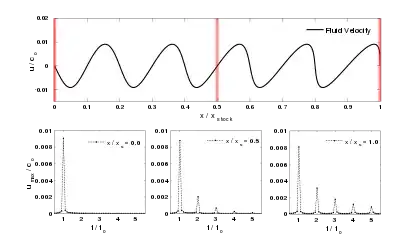I would like to understand how a shock wave is formed starting from the comservation equations. I know how to obtain a the wave equation with a perturbative approach (i.e assuming very small perturbation) but I cannot understand how to extend the problem considering non linearity. In particular I would like to understand the wave steepening process. Also any resource about this topic is well accepted (maybe with not too much mathatical formalism). Thank you.
2 Answers
I specialize in acoustics, and so I will discuss shock formation in that context. There are other ways shocks can form (e.g., super-sonic flow over a rigid barrier), but as they may be different (I don't know), I will exclude them from my discussion.
Linear acoustics is, as you say, a perturbation of the fluid mechanics equations. If the small perturbation term is $\epsilon$, the peak particle velocity over the wave speed, or the acoustic Mach number, then linear acoustics comes from neglecting all terms $O(\epsilon^2)$. If, on the other hand, you only neglect terms $O(\epsilon^3)$, you will get a nonlinear set of equations. These equations account for more phenomena than the linear equations.
One of the new phenomena accounted for is wave convection. If you have a non-zero particle velocity, that particle velocity can act kind of like a wind. The portion of an acoustic wave propagating where there is positive particle velocity will feel like the wave speed is actually the regular wave speed plus the local particle velocity. Similarly, if the particle velocity is negative (or going backward relative to the propagation direction), then the wave speed would seem to be a little less than the regular wave speed. The net effect of this behavior, called wave convection, is that the higher the amplitude of a portion of a wave, the faster it travels.
Now imagine a sine wave generated at $x=0$ (image from Wikibooks). Notice in the image how the peaks seem to be moving forward a little more than the troughs do. Eventually, you get to the point where one peak overtakes the trough ahead of it (right-hand side of the image). If we were to follow the trend after that point, you would wind up with a wave that has overlapping values at a single point in space. This actually happens for water waves (think of waves crashing), but it cannot happen for acoustic waves. Instead, after the peak and trough meet, a discontinuity in the acoustic pressure and particle velocity forms (note that we are ignoring linear thermoviscous losses at this point). This discontinuity is a shock wave.
Naturally, for low-amplitude waves the wave convection effect becomes less and less important, hence only appearing in the $O(\epsilon^2)$ terms. Also, I have simplified the discussion; there are other phenomena that impact shock formation, but I believe that wave convection is the dominant one.
Any reference I can give you will be relatively heavy mathematics, but one that may be a little easier is "Nonlinear Acoustics" by Beyer. Other good references comes from "Acoustics" by Pierce, and "Nonlinear Acoustics" by Hamilton and Blackstock.
- 2,085
In particular I would like to understand the wave steepening process.
Nonlinear wave steepening can be thought of conceptually as the wave phase speed depending on the wave amplitude. That is, larger amplitude waves will propagate faster than lower amplitude waves. If there is nothing to limit this steepening process, the wave will undergo wave breaking. If there is something to limit the steepening, the pulse can be prevented from breaking. If the process limiting the pulse is irreversible, then a stable discontinuity called a shock wave can form.
In an acoustic wave, the phase speed, $C$, depends on the mass density, $\rho$, of the fluid in question. So for these waves we have $C = C\left( \rho \right)$. If we then have $\partial_{\rho} C\left( \rho \right) > 0$, this states that the wave will steepen. It's another way of saying the wave is compressive and all compressive waves steepen in the absence of sufficient dissipation.
Phenomenologically, you can think of a steepening wave like a series of little steps. The lowest step has the smallest $C\left( \rho \right)$ and so will be caught by the immediately trailing step. The next step will catch these two and so on.
Also any resource about this topic is well accepted (maybe with not too much mathatical formalism).
I have some more discussion and references at: https://physics.stackexchange.com/a/139436/59023
You may also find the following discussion useful: https://physics.stackexchange.com/a/381974/59023
References
- Whitham, G. B. (1999), Linear and Nonlinear Waves, New York, NY: John Wiley & Sons, Inc.; ISBN:0-471-35942-4.
- 16,028
